These easy and quick Old-Fashioned Walnut and Celery Sandwiches are packed with a Vintage Walnut and Celery Vegan Mayonnaise Filling, that does resemble a classic Waldorf Salad but not quite! The fresh flavours and crunchy textures of these vegan sandwiches are amazingly and surprisingly moreish perfect for vegans, vegetarians, plant-based diets, as well as those non-vegan members of your family.
A tasty variation is to add in some chickpeas for a delicious vegan take on a 'chicken' salad sandwich. Oh and if you are looking for a Waldorf Salad do check out our family favourite recipe - Easy Vegan Traditional Waldorf Salad - which also makes a delicious vegan sandwich filling - just with more ingredients!
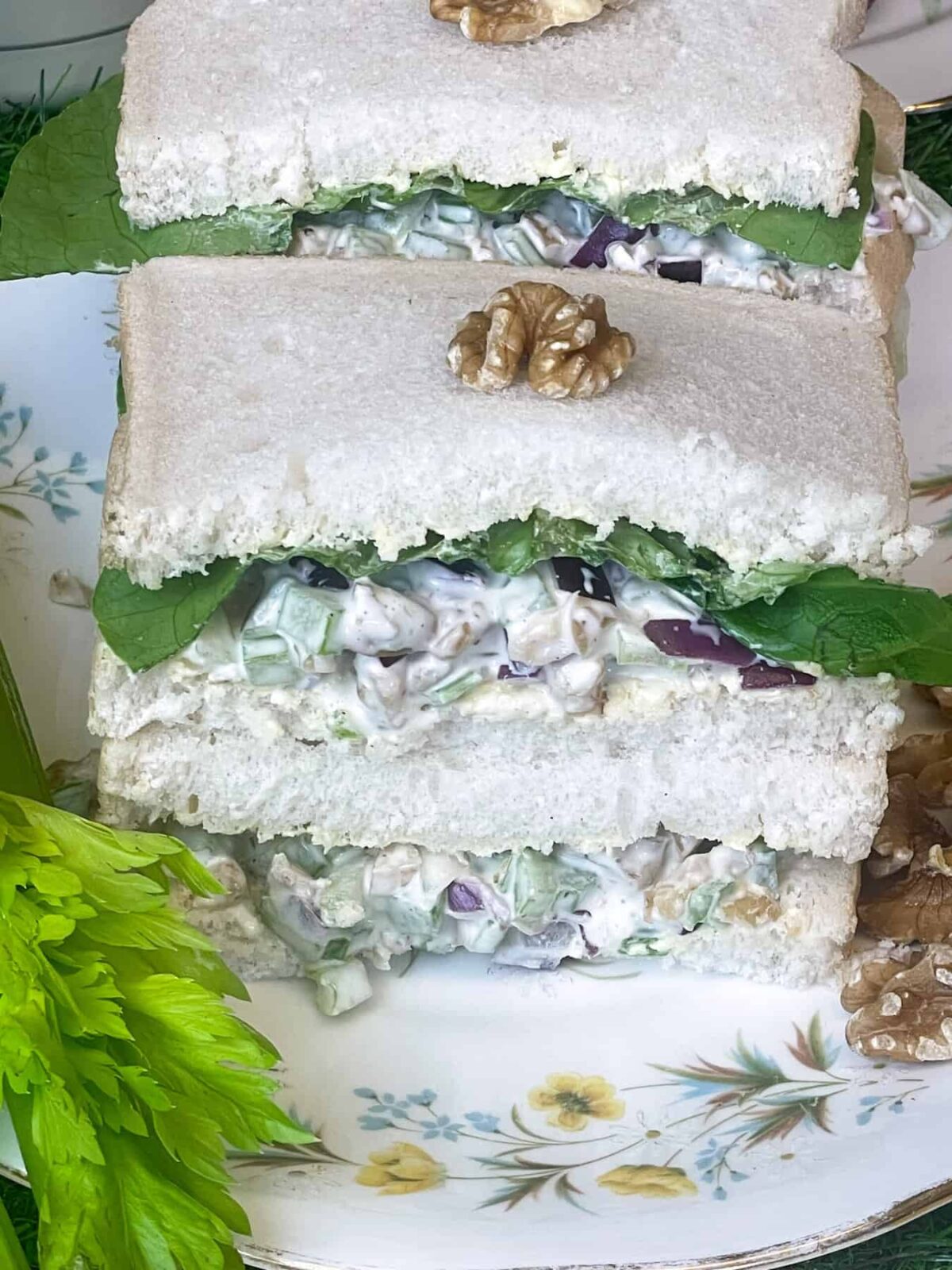
Walnut and celery sandwiches are perfect for plant-based, vegan, vegetarian, and meat-free sandwiches. Each bite is packed with fresh, savoury, creamy, crunchy goodness and the filling can be used with bread, tortilla wraps, pitta breads, flatbreads, etc., or stuffed into large lettuce leafs for the the best ever lettuce wrap filling.
Jump to:
Celery and walnut a tasty pair for centuries
Celery and walnuts beautifully compliment each other in texture and flavour and have been popular ingredient combinations in salads, sandwiches, stuffings, and other savoury recipes for centuries. The crisp, creamy, and slightly bitter taste of walnuts is just lovely paired with the crunchy, subtly sweet and bitter, grassy flavour of celery.
Not only does celery add budget-friendly tasty interesting flavours to sandwiches and salads, the combination of celery and walnuts also compliment each other nutritionally. So, why not enjoy a vintage inspired sandwich and taste just how delicious history can be. Although, if you have allergies or intolerances to walnuts or celery then of course do avoid these ingredients, and have a look at our ingredient substitutions provided below in the recipe notes and FAQ section.
Old-Fashioned Walnut and Celery Sandwiches
It might seem surprising to use walnuts and celery as a sandwich filling, but this combination was popular during the early 1900s and throughout the World War II years in Britain (1939-1945). During this period, many British people were encouraged to start gardening by the "Dig for Victory" campaign, which resulted in many households cultivating their own kitchen gardens.
During the 1940s, celery was often simply paired with mayonnaise to create frugal yet delicious sandwiches.
Additionally, the combination of celery and walnut for sandwiches and salads, featured frequently in British cookbooks during the 60s, 70s, and 80s. Given this history, it's logical to infer that walnut and celery sandwiches likely originated in Britain. However, similar old recipes can also be found in the US and Australia, although many of these older recipes additionally included chicken with titles such as "chicken, walnut, and celery salad" or "chicken, walnut, and celery sandwiches."
Origin of celery
Celery has been cultivated for thousands of years, and originated in the Mediterranean region and was used by the Ancient Greeks, Romans and Egyptians for medicinal purposes.
In Britain, a written mention of celery was recorded by John Evelyn, a 17th-century writer and gardener, who included celery in a list of "sallets" (salads) in his 1699 work "Acetaria: A Discourse of Sallets." Although the celery was spelt differently and was written as ''Sellery'' and was a different variety to the modern celery we have in the supermarkets.
Evelyn described the celery leaves and stalks being used in salad along with a dressing of oil, vinegar, salt and pepper [pg 42]. Evelyn's book can be read online over on Project Gutenberg.
The cultivation of celery in Britain was initially quite difficult, as traditional celery varieties were not well-suited to the British climate and required a lot of care to grow well. Also early celery varieties tasted much stronger compared to our modern celery.
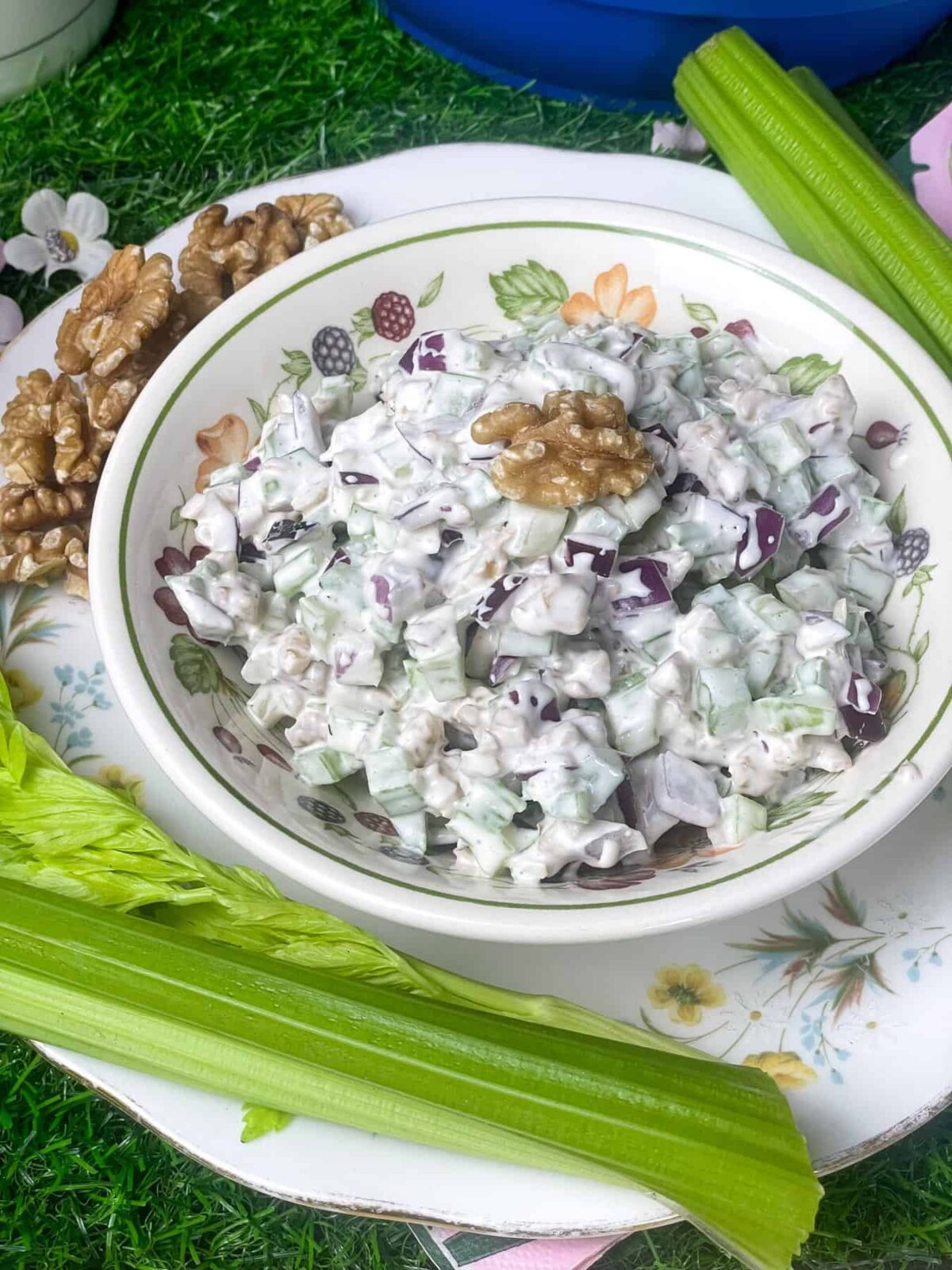
This old-fashioned sandwich filling is so easy to prepare with three main fresh ingredients - celery, onion, and walnuts - brought together with a little seasoning and your go-to mayonnaise which can be either shop bought or a home-made mayo. The old-fashioned time-honoured recipes are just the best.
Victorian celery was a status symbol!
Celery was very popular during the Victorian Britain (1837–1901). The Victorian era at least for the upper classes was a time of experimenting with exotic ingredients and elaborate recipes inspired by foreign food trends. Whereas the poorer classes food options was very limited to basic staples such as - potatoes, cabbages, turnips, bread, oats, cheese, cheap cuts of meat, and many cups of tea!
Celery, despite its humble nature, was considered a status symbol during this period as it was tricky to cultivate, requiring deep, rich soil, plenty of water, and a process called blanching (covering the plants to prevent them from turning green and developing a strong flavour) to make the stalks edible.
The time, effort, and expense involved in growing celery made it a luxury item, and it was often showcased in ornate, specially designed glass or crystal celery vases at the dinner table! The celery would be placed upright in the vase which was filled with a little water to maintain the celery freshness.
It was during the 19th century that a variety of celery, more suitable for the British climate and palate, was developed. This newer, more subtly flavoured celery soon became a staple in British cuisine.
Mrs Beeton's 1800s celery recipes
Mrs Beeton's Book of Household Management," published in 1861, shares the author's perspectives on celery. As Mrs. Beeton notes: "With a good heart, and nicely blanched, this vegetable is generally eaten raw, and is usually served with the cheese." (Chapter XXIV. General Observations on Vegetables). Nuts such as walnuts and almonds also made frequent appearances with the Victorian cheese course.
One of Mrs Beeton's recipes for a creamed celery dish instructs readers to cut celery into 4-inch lengths and to cook the pieces in broth until tender, usually taking about 20-25 minutes. Next, a thickening mixture of cream, butter, and flour is added to the celery (presumably equal parts, for instance, 1 tablespoon of butter mixed with 1 tablespoon of flour), along with a pinch of ground mace, a touch of nutmeg, and salt and pepper to taste.
According to Mrs. Beeton, creamed celery should be served "garnished with snippets of toasted bread," - which does sound like a delicious, budget-friendly lunch.
In another interesting recipe, Mrs. Beeton suggests boiling celery sticks, but first cutting the celery so the tips resemble points. Then after draining the cooked celery, arranging the sticks on a dish and covering them with a ready prepared white sauce or melted butter, and serving over toasted bread. Prepared this way, celery can replace asparagus, Mrs. Beeton claims.
In modern times, as celery is less expensive than pricier asparagus, Mrs Beeton's pointed celery could be a budget-friendly asparagus alternative!
Returning to the past, even into the 1900s Celery was still being valued as a high class ingredient as it was served to the first-class diners onboard the sadly doomed ship The Titanic in 1912.
Celery's downfall into an everyday staple ingredient
In modern times, celery has become a staple of British recipes, as well as multiple other cuisines, and is featured in a countless traditional recipes due to its ability to enhance background flavours.
Celery is particularly beneficial in vegetable broths or stocks, or as a foundational ingredient like in the classic French mirepoix, a blend of onions, carrots, and celery. It's also integral to the 'Holy Trinity' of Creole and Cajun cuisine, which consists of of mix of bell pepper, onion, and celery.
Despite its prevalent use in various cuisines and cooked recipes, raw celery is not to everyone's taste and it seldom makes it onto any UK Favorite Vegetable Lists! However, celery did make it to number 27 in this recent The Most Popular Vegetable list in the US!
Yet, celery is worth reconsidering even if you're not a fan as it's a relatively inexpensive vegetable that's nutrient-rich and loaded with antioxidants. Plus, its unique flavour profile shines in certain combinations - like in a sandwich paired with crunchy walnuts and creamy mayonnaise! So do give it a try, as you will likely be pleasantly surprised.
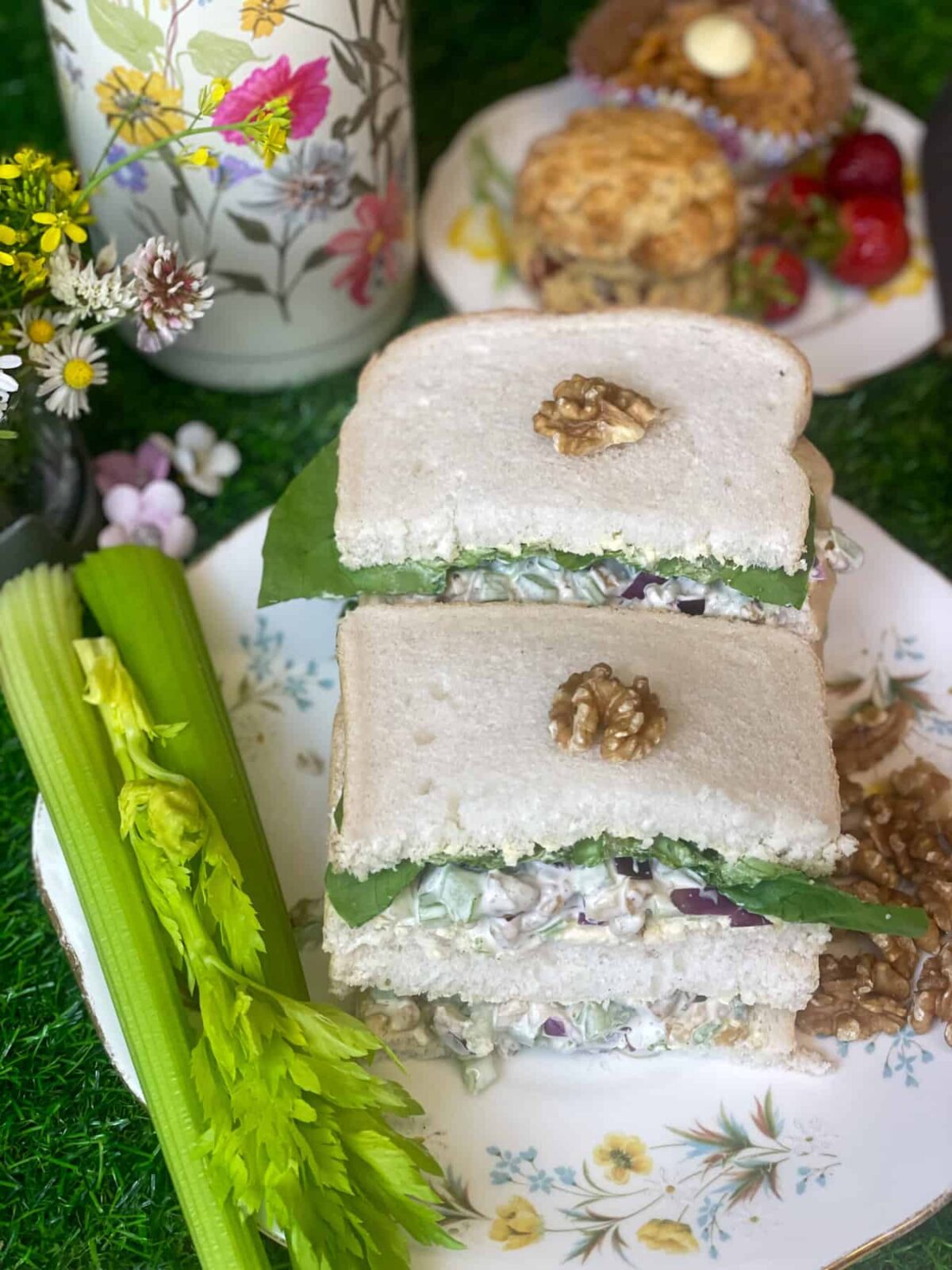
Fined diced celery and walnuts are the ideal sandwich partners and combined with red onion and creamy mayonnaise they make a delicious fresh tasting sandwich that is just so moreish. These vegan sandwiches are perfect for picnics, parties, buffets, pot-lucks, pack-lunches, and afternoon teas.
Origin of walnuts
The walnut tree, specifically the Persian or English walnut (Juglans Regia), is thought to have originated in Persia, however the oldest known archaeological remains of walnuts, date back to 7000 B.C., and were dug up in Southwest France.
The term "English" walnut is exactly the correct term as they are really "Persian Walnuts" as they were brought to England from Persia (modern-day Iran) via the Silk Road trade routes. The English merchants then distributed the nuts across the English-speaking world, and they soon came to be known as English walnuts.
Walnuts are believed to have been introduced into Britain by the Romans, similar to many other foods we now consider quintessentially British such as apples, pears, and cherries. The Romans also brought over celery. However, it took many more centuries before the walnut tree became a common sight in Britain.
During the Tudor era (1485–1603), walnuts were considered a delicacy, and walnut cultivation was encouraged so that by the 18th century, Britain had a significant walnut industry. Although, this later declined due to competition, when America decided to grow walnuts as theirs was a more efficient venture seeing as the American climate was more favourable for growing walnuts.
Throughout the centuries old British cookbooks frequently contained recipes that included walnuts, especially during the British Victorian era when pickled walnuts, in particular, were a common condiment. Walnuts were harvested while still green, then pickled in vinegar and spices to be used throughout the year. The pickled walnuts could be served alongside savoury dishes or used in various recipes.
In addition, walnuts were also consumed as a snack, either raw or roasted and they were considered a festive treat during the holiday season, and are often found in old recipes for Christmas puddings, steamed puddings, mince pies, candies, cakes, biscuits and many other pudding and dessert recipes.
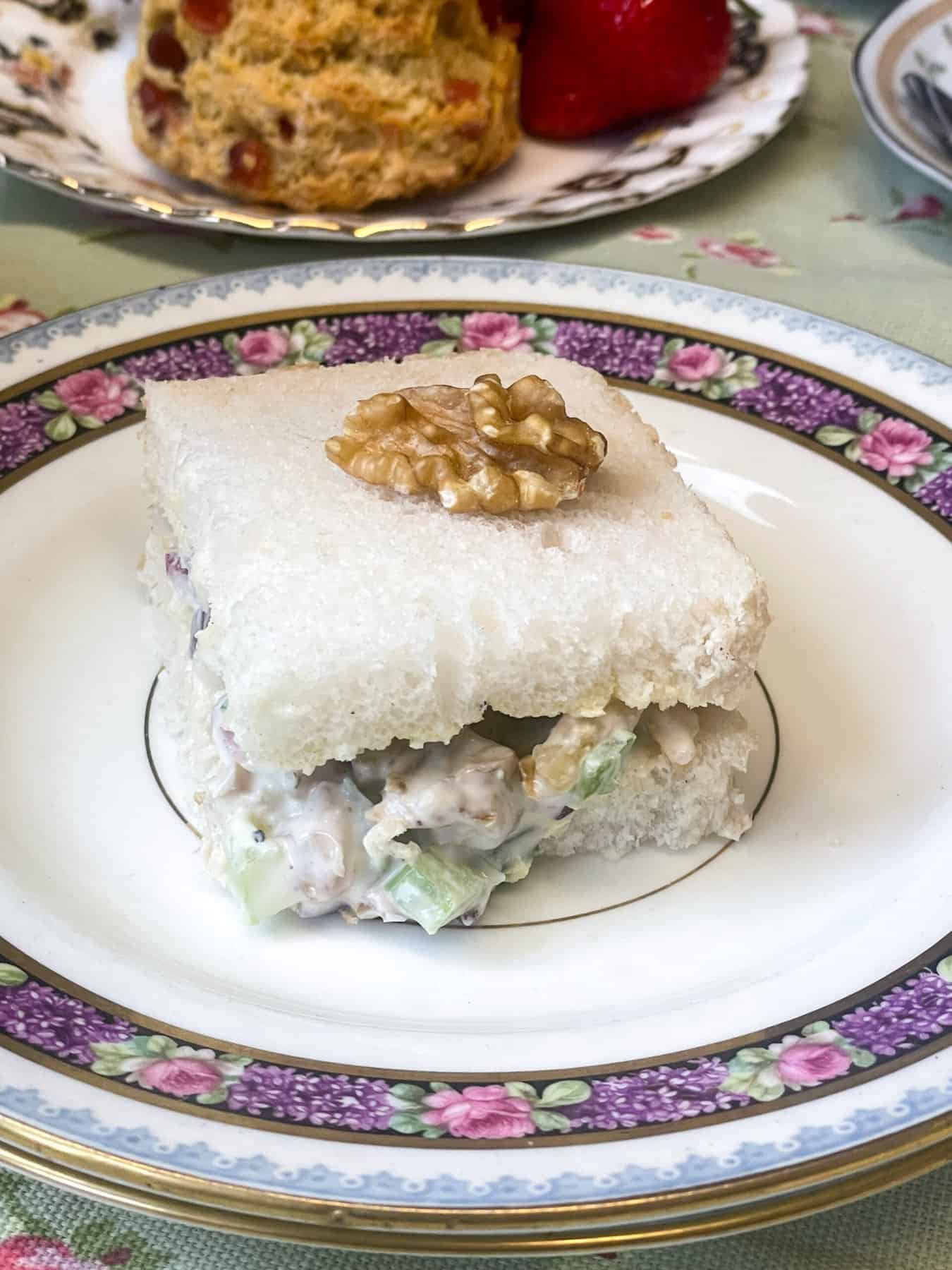
Classic Waldorf Salad
The combination of celery and walnuts in a sandwich or for a salad may have been influenced by the classic Waldorf Salad, which is said to have been created at the Waldorf-Astoria Hotel in New York City in 1893.
This salad contained apples, celery, and walnuts mixed with mayonnaise, and it quickly became a popular salad recipe across the United States and eventually globally.
However, perhaps the original Classic Waldorf Salad got its inspiration from older recipes or dishes, that already contained celery and walnuts, and the chef simply decided a few more additions could elevate the classic combination.
There are now many Waldorf Salad recipe variations that also include ingredients such as raisins, grapes, chicken, blue cheese, different nuts, yogurt dressing instead of mayonnaise, Waldorf coleslaw, and of course vegan and plant-based Waldorf Salads such as our Vegan Waldorf Salad recipe.
How to prepare
These easy sandwiches can be prepped in minutes and to save time the filling can be made up in advance and stored for up to 3 days or so within the refrigerator. Storing is advance is actually a great idea as the flavours get a chance to mingle and mellow creating a delicious fresh, crisp, and flavour packed sandwich filling.
You can also use this recipe to create a creamy walnut and celery salad that would be a tasty addition to any salad, buffet, or enjoy a scoop as a coleslaw replacement.
The ingredients you will need are celery, red onion, walnuts, mayonnaise, salt and pepper. We also add a little pinch of sugar but this is optional. If you are preparing sandwiches you will need bread and butter/margarine. We also like to use some lettuce with the sandwich filling.
As we are a plant-based family we use vegan mayonnaise but of course you can use your preferred mayonnaise for this recipe - including a home-made mayonnaise.

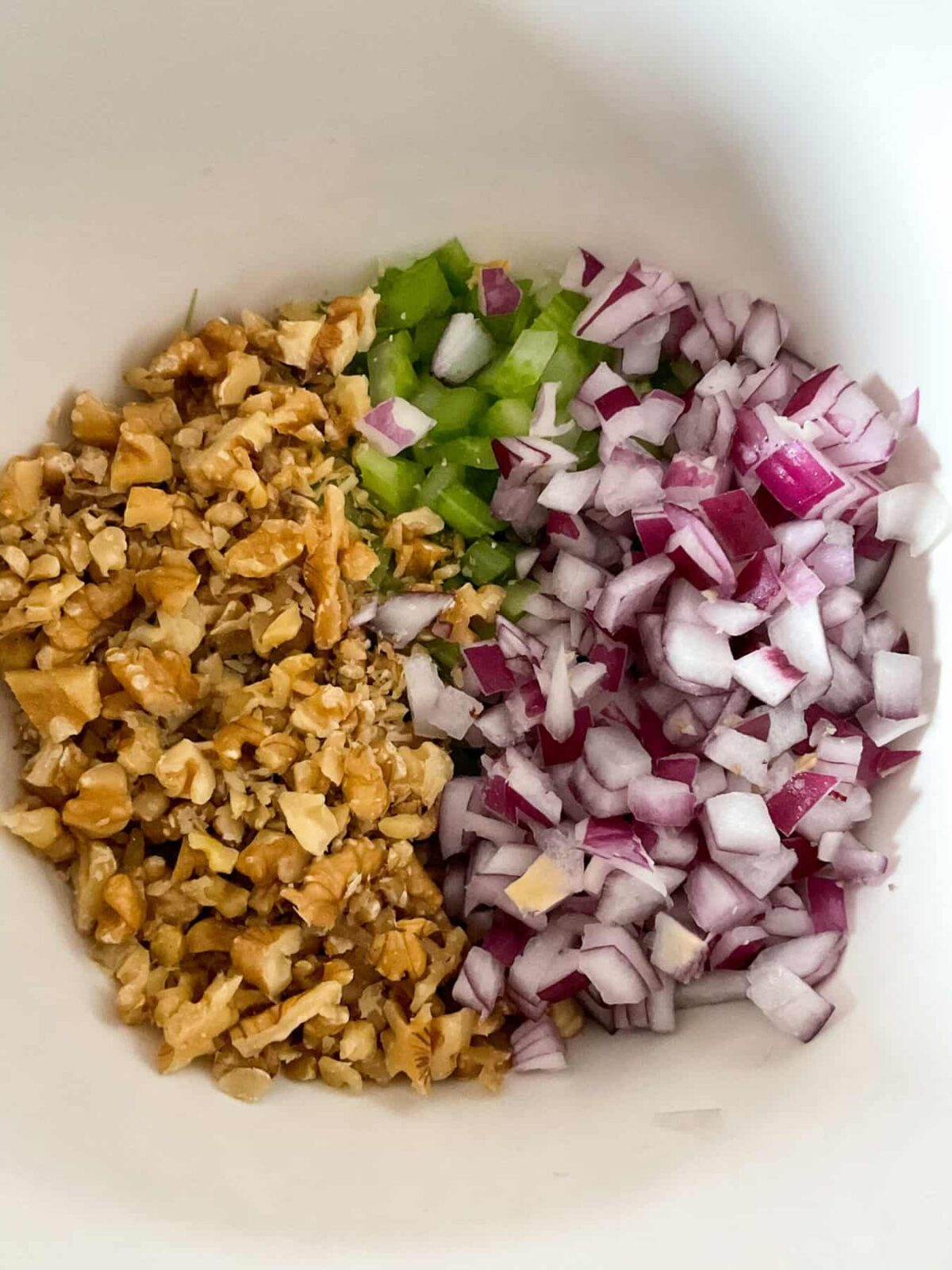
Step 1: First, dice the celery, red onion, and walnuts as small as you can get them, although they don't have to be very small.
Step 2: Add the celery, walnuts, and onions to a mixing bowl.
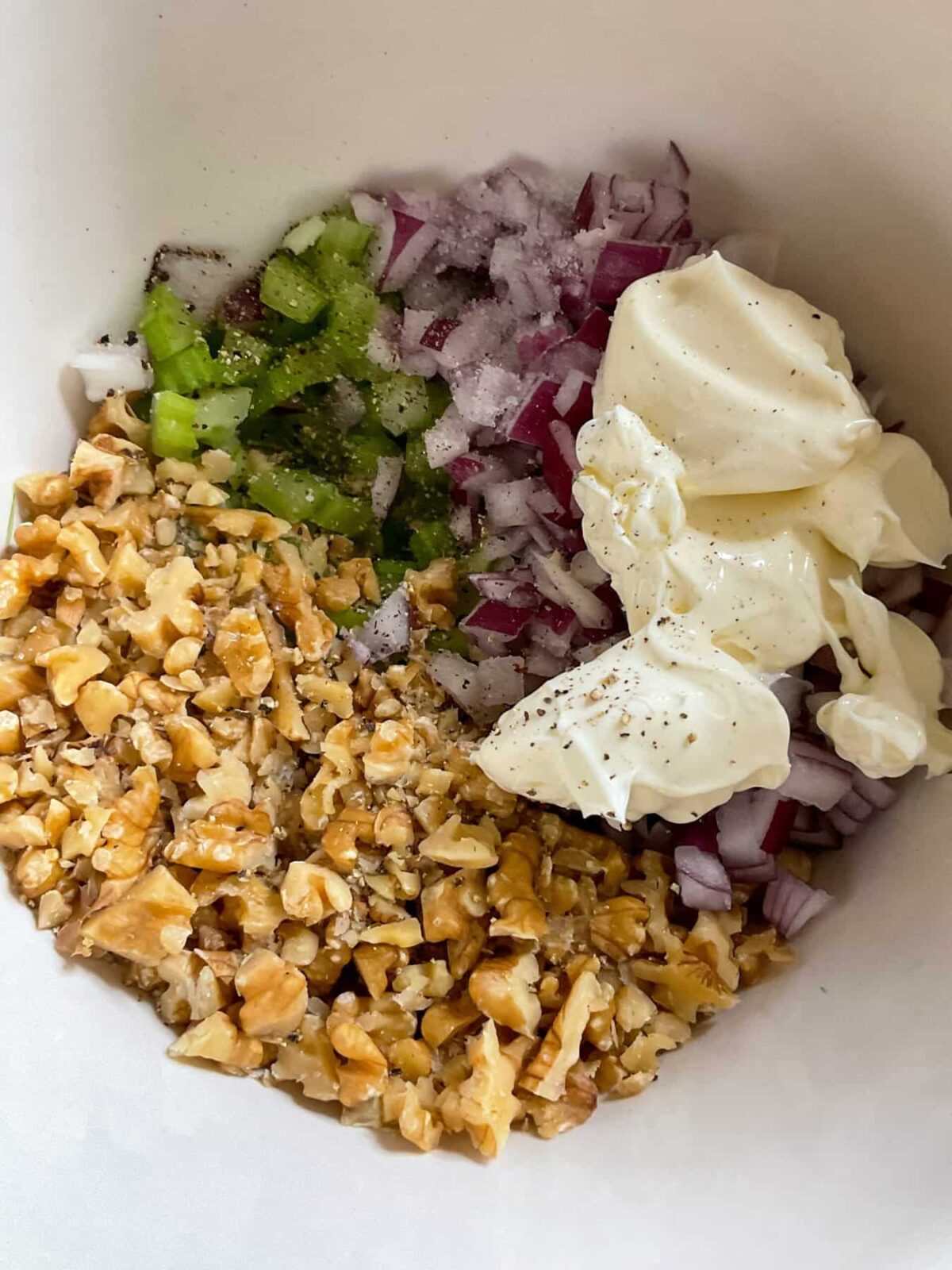

Step 3: Add the mayonnaise along with some salt, black pepper and a little pinch of sugar. Give it all a good stir and add more salt and pepper to taste.
Step 4: If the red onions tastes a wee bit nippy then the filling does benefit from sitting in the refrigerator for a wee while before using, as the sugar will help mellow out the onion.
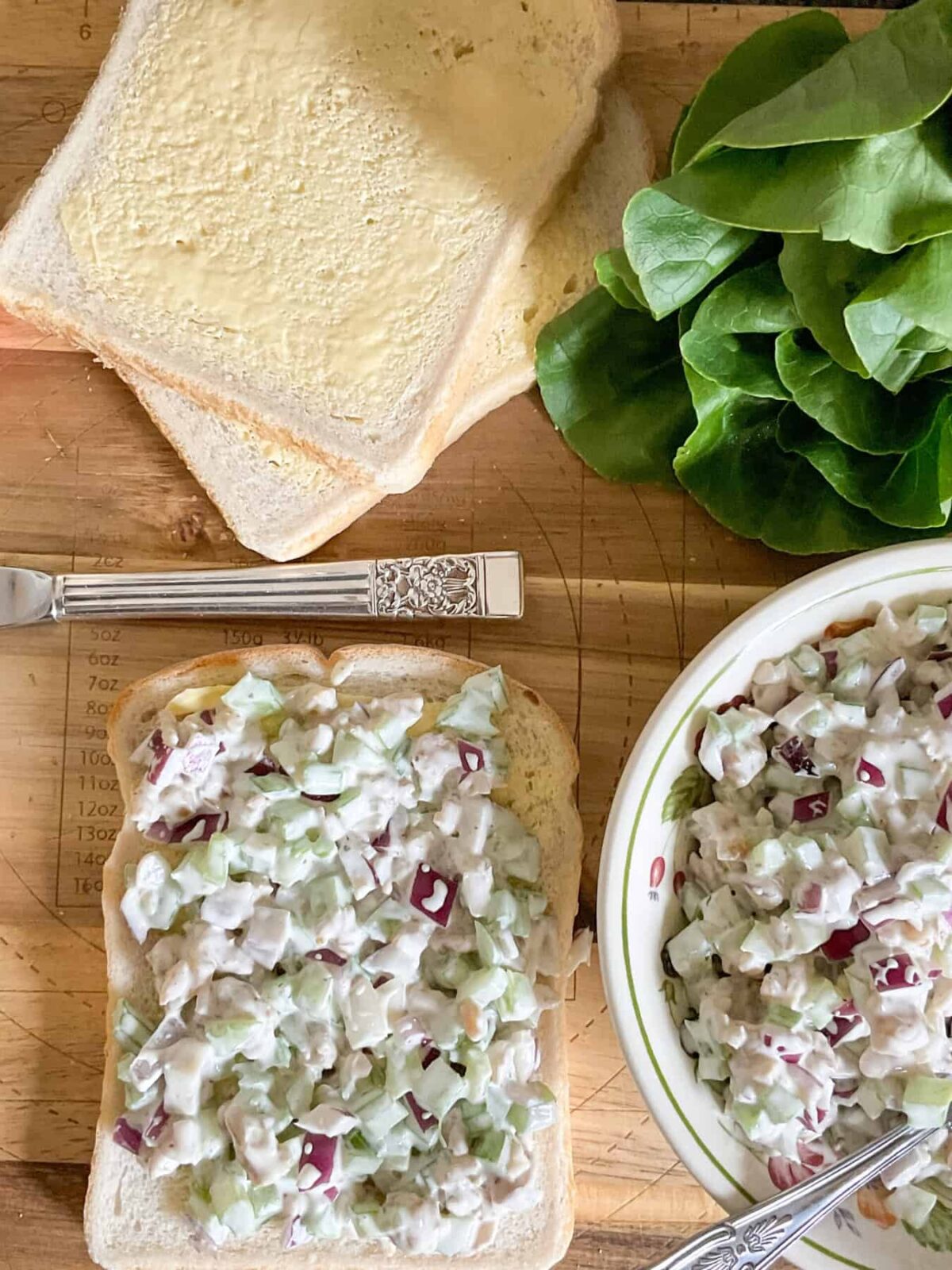
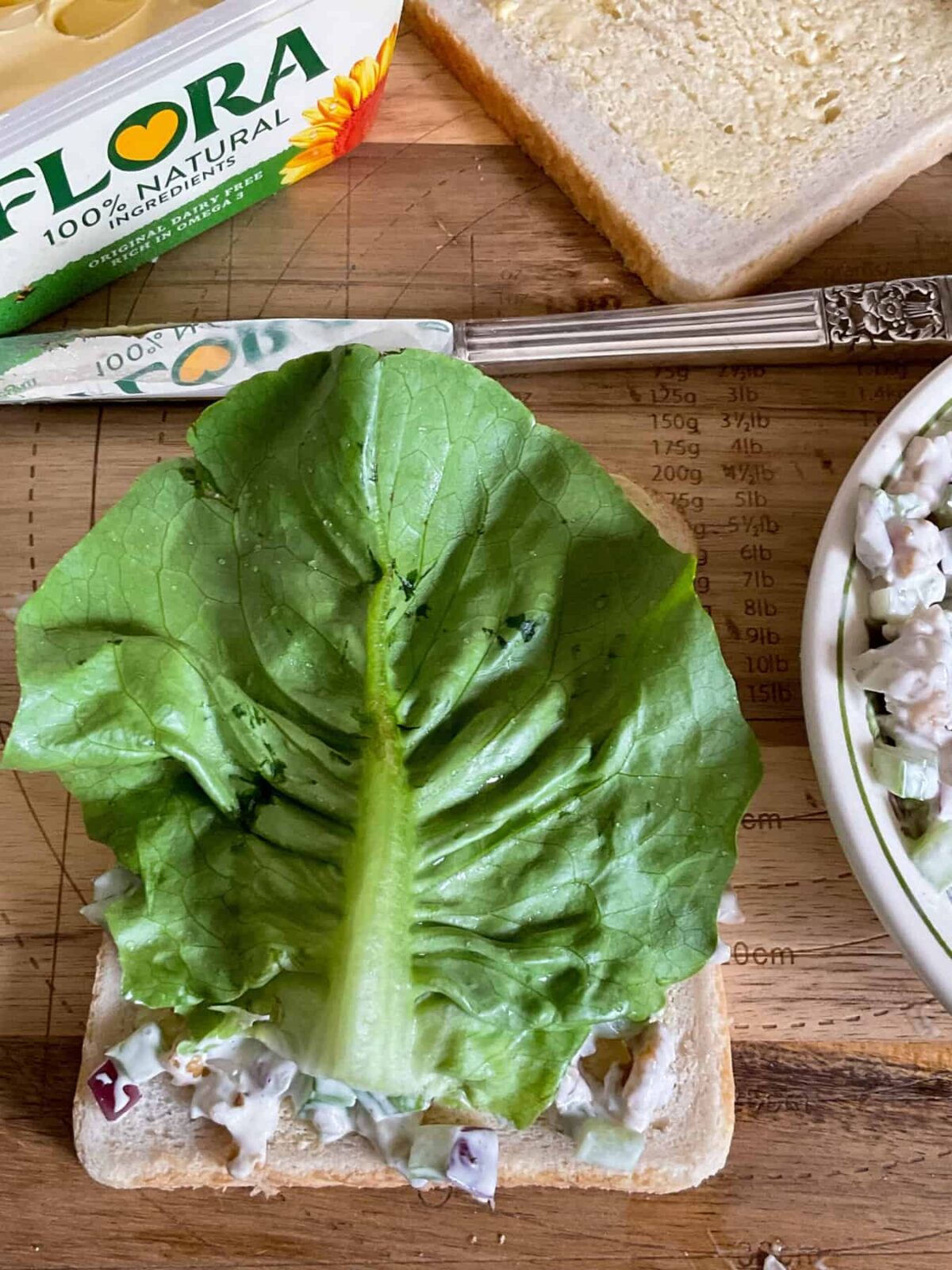
Step 5: When ready to use the filling, spread some margarine over your bread and top with a few big scoops of filling.
Step 6: If using lettuce you can add some over the filling and then place another slice of buttered bread on top.

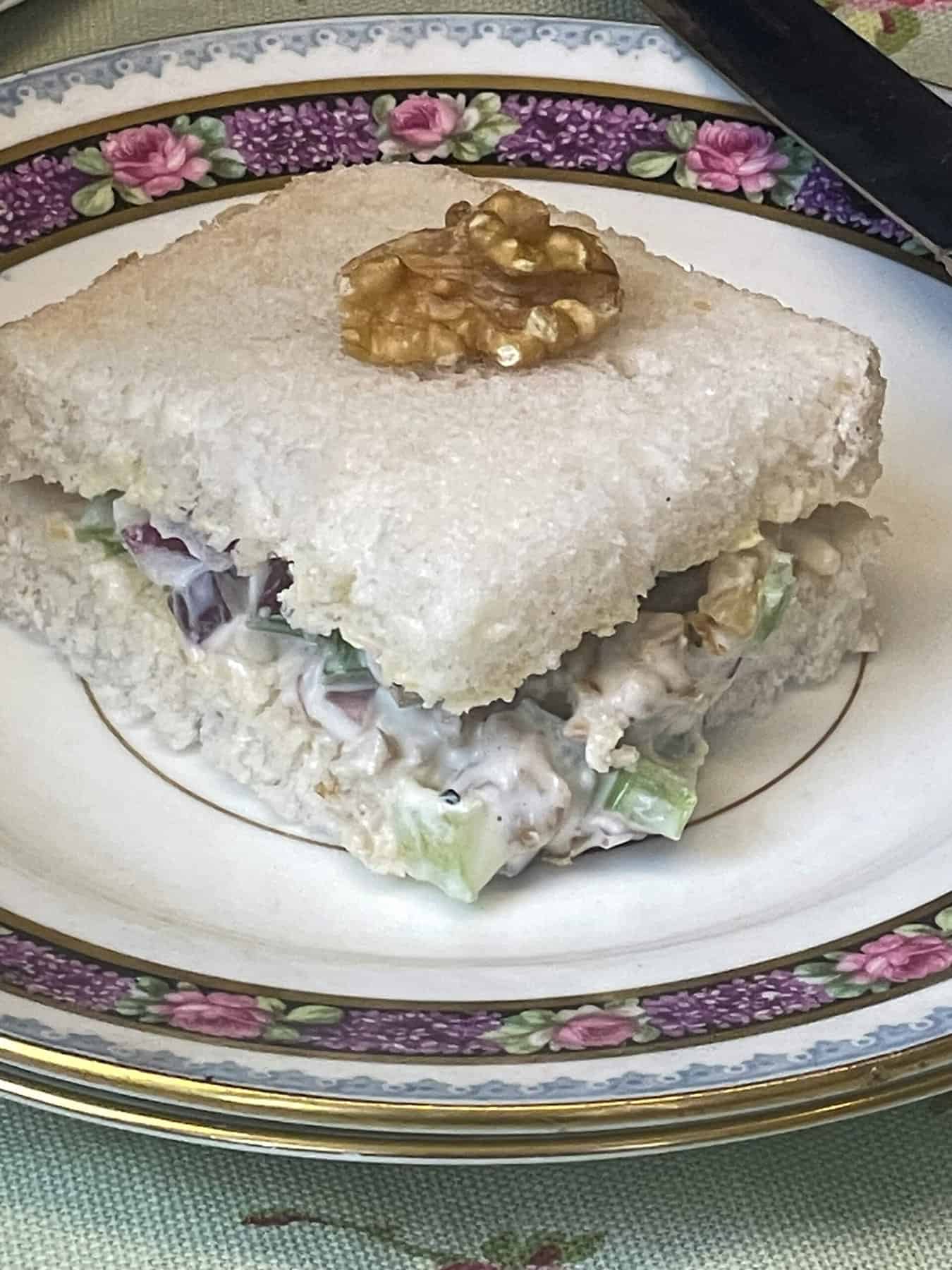
Step 7: Slice each sandwich into 2 triangles or 2 rectangles and then into a further 2 smaller pieces if liked. The smaller squares or triangles of sandwiches are great for afternoon tea, party spreads, buffets or picnics.
Recipe notes
Storing
Store leftover sandwiches for 1-2 days, wrapped with food-safe wrap or kitchen foil and place into a covered container. The sandwiches will be at their best soon after they are prepared.
To store the sandwich filling: The filling can be stored within the refrigerator for 3 days within a covered container.
FAQ'S
Yes, the filling is gluten-free but do check your mayonnaise ingredients just to be 100% sure, and select a gluten-free bread to use with the filling or use a gluten-free bread alternative.
There are so many creative bread alternatives available so if you can't have bread due to a dietary requirement, allergy, intolerance, or some other reason, there are many ideas to choose from:
* Use large lettuce leafs to prepare lettuce wraps - large romaine or Cos leafs are great for wraps. However iceberg or butter lettuce, or blanched collard greens or spring green leafs are also a good option. Use our easy guide for blanching thicker greens: To blanch large intact collard or spring green leafs plunge each leaf into a pan of boiling water for just 30-60 seconds [not any longer as you risk softening the leaf too much] and then remove and plunge each leaf into icy cold water. Pat the leafs dry carefully with a clean tea towel or kitchen paper and then use as you would a tortilla wrap.
* Another idea is to grill, broil, or roast large flat mushrooms or Portobello mushrooms and then once cooked fill them up with a fresh sandwich filling. Similarly cooked slices of aubergine [eggplant] can also make a delicious bread alternative.
* Cucumber boats or subs can be a fun bread replacement and these can be prepared by slicing a cucumber lengthwise and scooping out some of the insides, and then stuffing with a sandwich filling. The scooped out cucumber can be mixed with the sandwich filling or used for a different salad.
* Likewise a bell pepper can be sliced into wide pieces, seeds and inner white bits removed, and then stuffed with a sandwich filling to create crisp bell pepper open sandwiches.
* An easy choice is to replace the bread with crunchy rice cakes or corn cakes, lentil cakes, Quinoa cakes, pea cakes, etc. Some varieties are a mixture of grains.
* Crisp Scottish oatcakes are a delicious bread alternative [although these are not gluten-free unless gluten-free oatmeal is used] and can be used to create little canapés that would be perfect for starters, aperitifs, or snacks. Simply add a scoop of sandwich filling to the middle of each oatcake or provide a small dish of sandwich filling and use the oatcakes to scoop up the filling.
* Crackers such as Ryvita, saltines, seeded crackers, gluten-free crackers, etc can be used to create open-faced sandwiches which would make delicious appetizers or quick snacks.
Yes you can although the red onion does add a delicious flavour and texture to the sandwich but it can be omitted if preferred. Also, the red onion can be replaced with a different type of onion such as sweet onions, yellow onions, white onions, shallots, spring onions [green onions], or chives.
Raw red onions can have a bit of a sharp bite when eaten raw but we have included a little bit of sugar in our celery and walnut sandwich recipe and when all the ingredients are mixed together and then left to chill for at least 10 minutes, preferably more, then this helps to mellow out the red onion.
However, to lessen the red onion bite before adding to the sandwich filling, add the chopped red onion to a bowl of cold water for about 15 minutes, drain well and then pat dry.
The walnuts can be replaced with any nut you prefer or perhaps replace the nuts with seeds. Also you can replace the walnuts with mashed up chickpeas, roasted or boiled chestnuts, diced apple, fresh bean or lentil sprouts, dried cranberries or raisins.
If possible do try the recipe with the celery as even if you usually dislike raw celery this filling may surprise you. However, if you would like to use a celery substitute do keep in mind that the texture and flavour of the sandwich filling will be different but it will still be a tasty sandwich or salad.
A few celery alternatives:
* diced bell pepper
* diced fennel
* diced cucumber
* grated carrot
* grated or diced radish
* diced or finely shredded white cabbage
* bean or lentil sprouts
Any shop-bought or home-made type of mayonnaise works well for sandwiches so just go with what you usually use.
We like to use an egg and dairy-free shop-bought mayonnaise. There are fat and oil-free mayonnaise recipes available so you can make a fat or oil-free home-made vegan mayonnaise if preferred - such as this easy silken tofu mayonnaise recipe over on the Dr McDougall website.
Instead of mayonnaise you can try - hummus, guacamole, tahini, cashew cream, thick yogurt, cream cheese, or creme fraiche. You may need to adjust the seasoning depending on what replacement you choose such as add a little prepared mustard, vinegar, or extra salt & pepper.
Yes you could add some cooked chickpeas, kidney beans, green lentils, or tofu, tempeh, edamame beans, bean or lentil sprouts, or sunflower, pumpkin seeds or hemp seeds which would boost the protein content.
As we are a plant-based family we often add a slice or two of vegan deli 'meat' or vegan Quorn meat free slices, or cooked vegan 'bacon', to the bread before scooping over the filling.
Finally, an easy way to add extra protein is to accompany the sandwich with a nice comforting bowl of home-made soup.
A nice cup, mug, or bowl of soup is the perfect accompaniment to a tasty round of home-made sandwiches. Soup and sandwiches are always a welcome hearty meal that can be enjoyed for both lunch and dinner.
We have plenty of homely and traditional soup recipes to choose from, including our easy Budget-Friendly Tomato Soup, and this rustic Hungarian Pepper Soup, and one of our family favourites this Scottish Potato and Leek Soup, or this Orcadian Oatmeal Soup.
For plenty more soup ideas check out our collection of Vegan Soup Recipes - which are packed with veggies and wholesome goodness and can be easily adapted for any dietary requirements.
Yes, you can use your preferred home-baked or shop-bought bread such as white bread, whole-wheat or whole-grain bread, rye bread, seeded bread, farmhouse bread, sourdough bread, granary bread, multi-grain, 50-50 bread, Toastie bread, low-carb bread, the list is endless!
Alternatively, use baguette, rolls, baps, English muffins, bagels, pitta breads, flatbreads, ciabatta, etc.
The Walnut and Celery Sandwich and the Waldorf Salad do share some key ingredients, namely celery, walnuts, and mayonnaise, but there are a few differences that warrant these as separate recipes:
1. The ingredients for a Waldorf Salad typically includes celery, apples, and walnuts, all tossed in mayonnaise. Sometimes, it may include raisins, sultanas, or grapes, with modern variations possibly adding chicken, turkey or a vegan meat alternative. On the other hand, a Walnut and Celery Sandwich typically includes celery and walnuts mixed with mayonnaise and doesn't usually include apples.
2. A Waldorf Salad is usually served as a salad, typically on a bed of lettuce whereas a Walnut and Celery Sandwich is served as a sandwich between two slices of bread or a bread alternative. Although the filling can be eaten as it is without bread.
3. The origin of the Waldorf Salad is claimed to have been first created at the Waldorf Hotel in New York City in 1893, whereas Walnut and Celery Sandwiches do not have a specific date of origin instead the combination of walnut and celery has been popular for centuries.
We do have a delicious Waldorf Salad family recipe which is perfect for summer BBQ sides, cookouts, buffets, picnics, and everyday light lunches or as a tasty side with dinner especially good with a baked potato.
Traditionally, for "dainty" sandwiches often served at occasions like afternoon tea, luncheons, high teas, or fancy buffets, the crusts are removed as this creates a more refined and delicate appearance, and it can make the sandwiches easier to eat in small, tidy bites.
However, the decision about whether you would like the crusts on or off depends on whether you enjoy the texture and flavour of the crust, or if you want a more rustic and hearty sandwich, then you might choose to leave them on.
So, if you're looking for a more traditional presentation then you might choose to remove the crusts. However, if the crusts are removed and not repurposed it can seem like a waste of food so if you do opt for crust less sandwiches, make sure that the crusts are turned into breadcrumbs and frozen for future use in recipes!
Yes, here are our best tips on preparing the best sandwiches -
1. Choose a bread that you like as this is the foundation of your sandwich, so make sure it's fresh and tasty. Consider the texture and flavour of the bread in relation to your fillings.
2. Spread your condiments, margarine, butter, etc., all the way to the edges of the bread as this ensures every bite is packed with flavour.
3. Think about how you layer your fillings and place the lettuce or other leafy greens next to the bread to create a moisture barrier that prevents the bread from potentially getting soggy from other ingredients. Although, if you're eating the sandwich right away this is less of an issue.
4. A good sandwich has a balance of flavours (sweet, salty, sour, bitter, umami) and textures (crunchy, crisp, soft, creamy, chewy). Although, very tasty sandwiches can simply have bread, margarine, cucumber slices, and salt and pepper! One of our simple timeless British favourites that never grows old!
5. Consider the temperature of your ingredients as this can affect the overall experience of the sandwich, such as whether you want an ingredient to be at room temperature or chilled. For example our daughter hates biting into chilled tomatoes! But for mayonnaise it always tastes better chilled.
6. Don't forget to season your ingredients, especially fresh ones like tomatoes, cucumbers, or avocados, as a little salt and pepper can bring all the flavours out.
7. Don't over stuff the sandwich with the filling! While it's tempting to pile on lots of delicious ingredients, too much filling, can make the sandwich hard to slice and eat.
8. Think about how you're going to cut your sandwich.
9. Let the sandwich rest for a few minutes! If you're using a soft filling, letting the sandwich sit for a few minutes before cutting can help everything settle and make it easier to eat. Although, if in a rush or starving just apply to face!
Yes, our recipe for celery and walnut sandwiches can be easily adapted into a vegan 'chicken' salad sandwich simply by adding in some cooked vegan 'chicken' style pieces or chunks, or some sliced up vegan 'chicken' deli slices or vegan Quorn 'chicken' slices, or add some cooked chickpeas instead. Of course, if you eat chicken then you can add that instead.
The exact amount is personal preference so just add as much as you like or as much as the recipe can take, adding more mayonnaise and seasoning if necessary. Also, the chickpeas can be given a quick mash if preferred, before adding.
As for the walnuts they can be either omitted or kept in the recipe, and a few teaspoons of a vegan-friendly 'chicken' seasoning spice and herb blend is a nice addition.

Walnut and celery sandwiches are ideal for an afternoon tea party along with your favourite delicious home-baking. At the top of the cake tier in the image above there are our tasty Peanut Butter Cornflake Cakes and in the middle tier there are our delicious Old-Fashioned Cherry Scones.
As we are a plant-based family all our home-baking recipes are egg and dairy-free but they taste just like the originals. For more vegan baking recipes that would be perfect for an afternoon tea or an any-time-of-the-day treat check out our collection of Vegan Baking Recipes.
More traditional meat-free and dairy-free sandwich recipes
Nothing beats a good old-school retro sandwich! Especially on those days when you don't feel like cooking as they can be paired up with an already prepared home-cooked soup or even a convenient can of soup.
Our Vegan 'prawn' Tofu Cocktail harks back to the classic prawn cocktail that was all the rage during the British 1970s, but it is making a come-back and its also quite delicious as a sandwich filling. Asda, Morrisons, and Aldi [UK] supermarkets have their own shop-bought version of a vegan prawn cocktail sandwich but a home-prepared one is always going to be better!
A few more of our family favourite sandwiches are this fun Ploughman's Lunch which can also be served as a platter, and this Coronation Chicken Sandwich which is packed with bean goodness, and for a vegan take on a classic our Tofu Mayonnaise Sandwich is the best.
***please note: for US measurements click the 'US customary button' within the recipe and the measurements will switch to tablespoons, cups, and ounces.***
📖 Recipe

Old-Fashioned Walnut and Celery Sandwiches
Equipment
- Vegetable knife
- cutting board
- mixing spoon
- Mixing bowl
- butter knife
Ingredients
Filling:
- 120 grams celery [weight is for 2 medium ribs after they have been trimmed, fine diced]
- 60 grams walnuts [fine diced]
- 70 grams red onion [about ½ a small onion, fine diced]
- 4 tablespoons mayonnaise [we used a vegan mayonnaise but you can use your usual mayonnaise- shop-bought or home-made or an equivalent]
- ½ teaspoon granulated sugar [optional, but does balance out the flavours]
Sandwich:
- 6 slices bread [use your preferred bread or sub with lettuce leafs]
- 1 tablespoon margarine [or your usual spread for bread, use more or less as preferred, or replace with a small amount of hummus or simply omit]
Instructions
- Spread margarine or butter over the bread slices.1 tablespoon margarine, 6 slices bread
- Fine dice the celery, onion, and walnuts, and add these to a mixing bowl. The exact size to cut the ingredients is personal preference but the smaller the better - although perfect dice is not necessary.120 grams celery, 60 grams walnuts, 70 grams red onion
- Stir through the mayonnaise and sugar and mix well.4 tablespoons mayonnaise, ½ teaspoon granulated sugar
- Season with enough salt and black pepper to bring all the flavours together.
- Pop the filling into the refrigerator for at least 10 minutes so that the flavours can mingle. The filling does benefit from being chilled so if possible do let it sit in the refrigerator. Alternatively, if preferred it can be used immediately.
- Add about a third of the sandwich filling to a slice of bread and top with a second slice. We also like to include some lettuce or green salad leafs with our sandwich.Cut the sandwich into rectangles or triangles, and slice again if liked, so that you have 4 pieces per sandwich.
Notes
- Nutritional data is provided for guidance only and is not an exact calculation as ingredients vary.
- The bread used for the calculation is labelled 'bakery bread' which is generally a white style loaf.
- Margarine or butter is not included within the nutritional data, as it can be omitted or replaced with a thin layer of hummus.
- Data minus the bread works out roughly at: 268 calories, 4g protein, 8g carbs, 25g fat,3g sugar, 1mg iron, 2g fiber, 41mg calcium [for ⅓ of the sandwich filling].
- The bread can be substituted for a large or small lettuce leafs such as romaine lettuce, Cos, little gems, etc.
- Or use the filling as a delicious dip for tortilla chips, Scottish oatcakes, crackers, etc.
- Store leftover sandwiches for 1-2 days, wrapped with food-safe wrap or kitchen foil and placed into a covered container. Although the sandwiches will be at their best soon after they are prepared.
- The sandwich filling can be stored within the refrigerator for 3 days and is best stored minus the bread, with the sandwiches made up just before eating or a few hours before eating and then stored properly, as this will avoid soggy sandwiches!
- Add the sandwich filling to your favourite salads, or as a side-dish whenever you would have coleslaw such as with veggie burgers or baked potatoes.
- Add extra flavours such as a vegan-friendly 'chicken' seasoning herb and spice mix, potato or chip seasoning, paprika, chilli powder, cayenne pepper, or your favourite herbs and spices seasoning mixes.
- Check out our recipe notes and FAQ section above for useful tips on different sandwich cuts, preparing the best sandwiches, celery and walnut substitutions, bread substitutions for sandwiches, mayonnaise substitutes, a link to a home-made vegan mayonnaise, and more!
- To prepare a vegan 'chicken' salad sandwich: 1. To the celery and walnut filling add some cooked vegan 'chicken' style pieces or chunks, or some sliced up vegan 'chicken' deli slices or vegan Quorn 'chicken' slices, or use some cooked chickpeas instead. 2. The exact amount is personal preference so just add as much as you like or as much as the recipe can take, adding more mayonnaise and seasoning if necessary. Also, the chickpeas can be given a quick mash if preferred, before adding. 3. As for the walnuts they can be either omitted or kept in the recipe, and a few teaspoons of a vegan-friendly 'chicken' seasoning spice and herb blend can be stirred through.
Nutrition
Comments
Prepared our tasty Old-Fashioned Walnut and Celery Sandwiches? Do pop back and let us know how you got on with the easy recipe. Did you use this recipe for an Afternoon Tea party, High Tea, Luncheon, Buffet, Party, Picnic, or other fun event? Do let us know! As we love hearing from you! Thanks so much, Jacq x
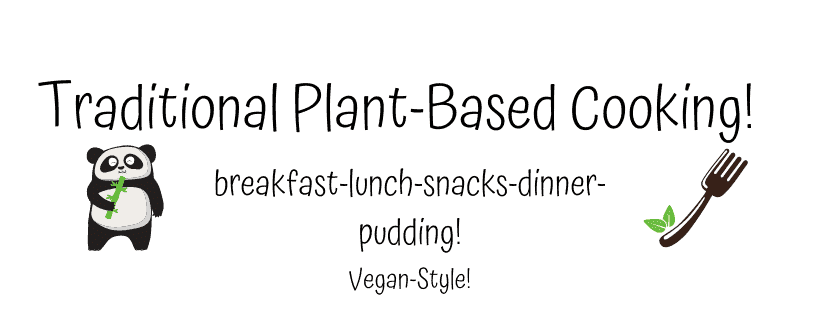

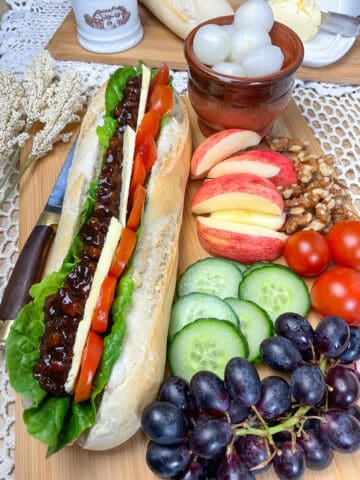
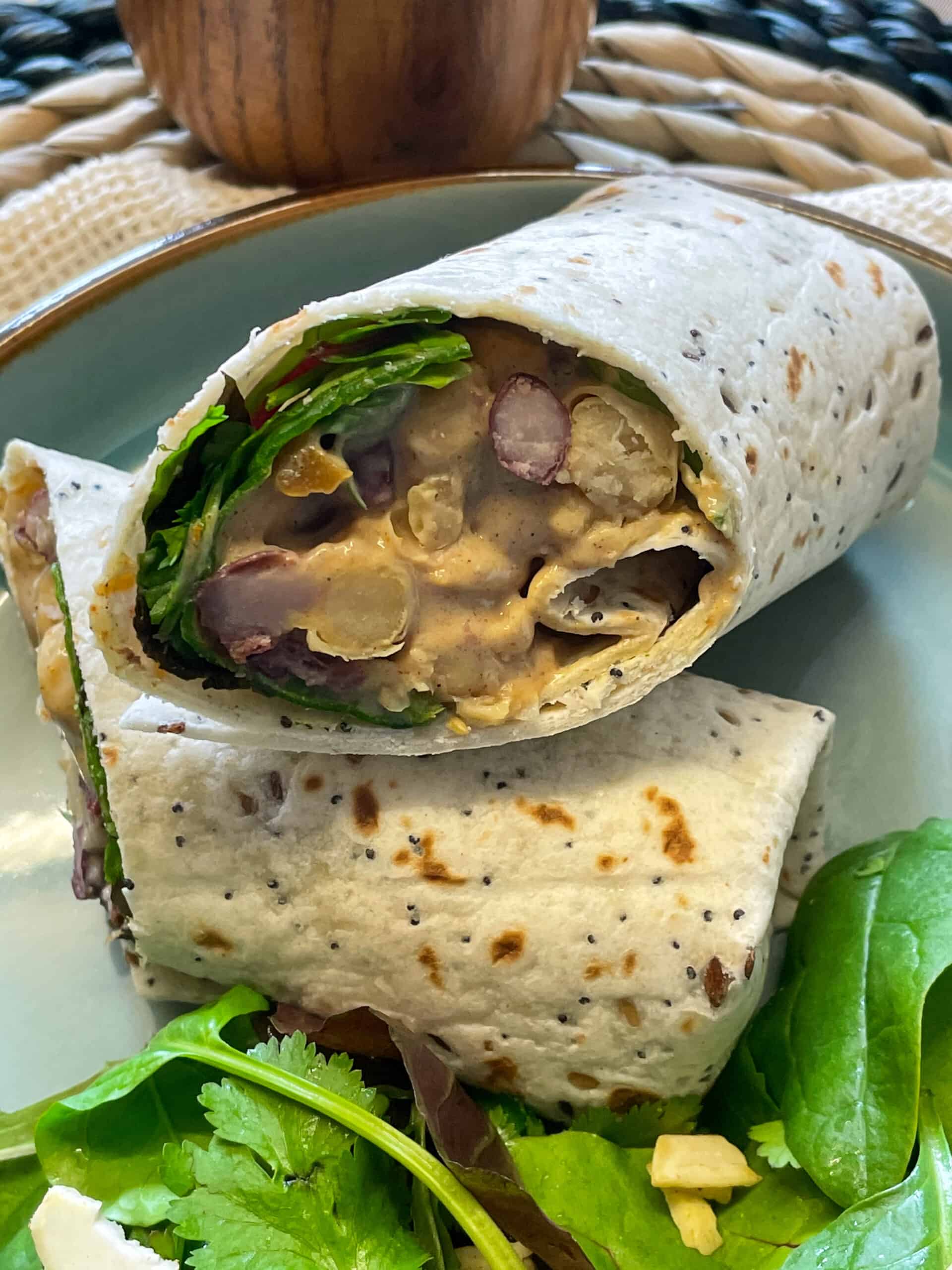
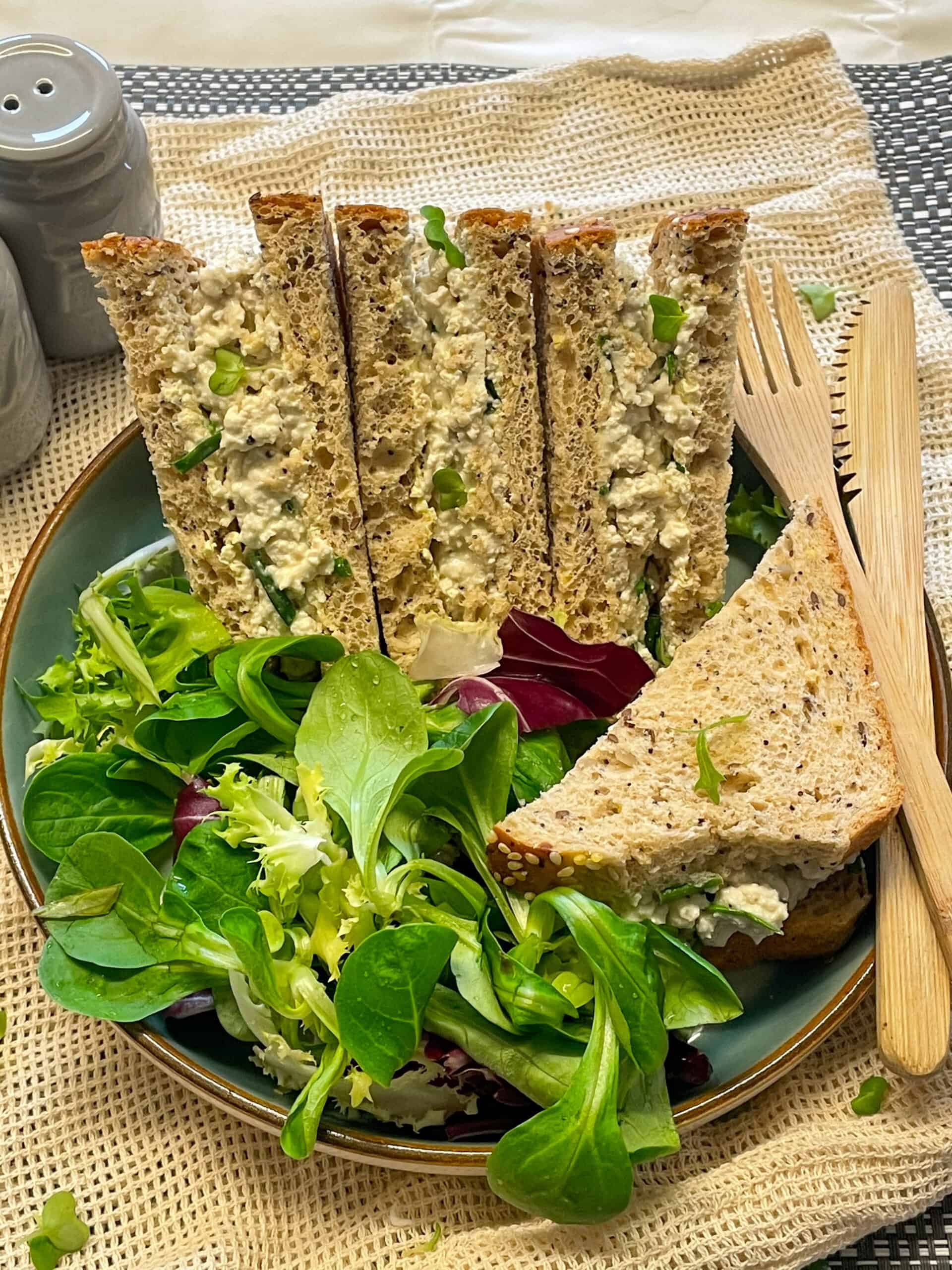
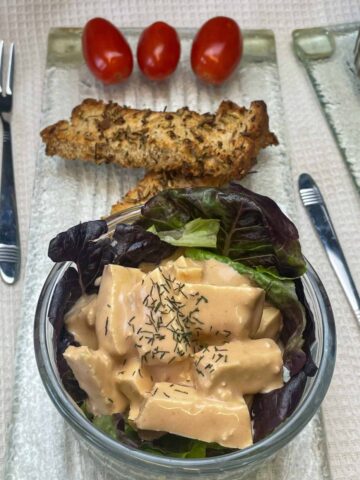

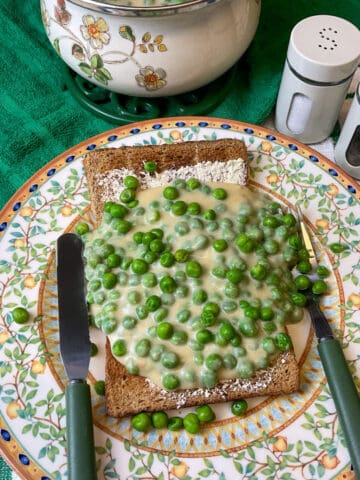

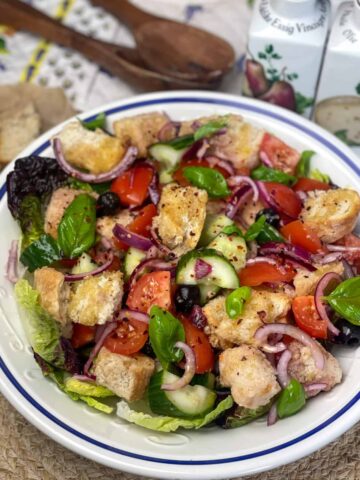
Leave a Reply